How Electric School Buses Benefit Kids’ Health, School Budgets, Jobs and More
Electric school buses do more than just bring kids to school. Cleaner air, school savings and more manufacturing jobs are just a few of the benefits of electric school bus adoption.
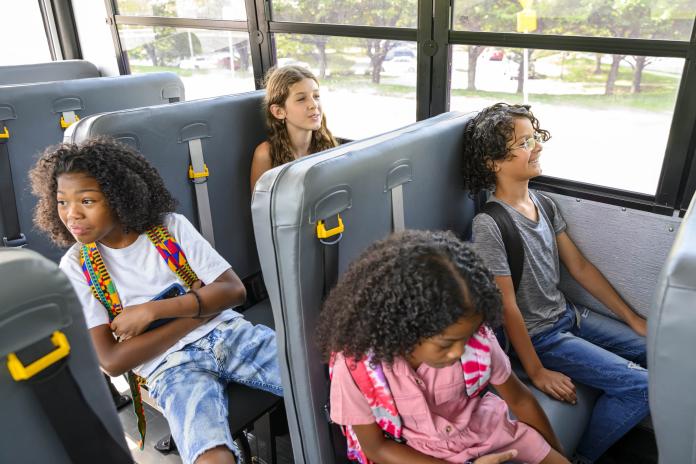
Electric school buses do more than just bring kids to school.
They provide a clean ride to students, free of the tailpipe pollution that harms lung health and brain development. Electric school buses can also save school districts and communities money over the long haul, which means more funding goes back to the classroom. And, because electric school buses don’t emit the greenhouse gases that trap heat in our atmosphere, they’re much better for the climate, too.
These are just a few of the biggest benefits of electrifying school bus fleets. Replacing old, polluting, diesel-burning school buses with electric alternatives can also bring jobs to the electrification workforce, build grid resiliency in communities and center equity in issues like air pollution.
Health benefits for kids — and everyone
Electric school buses are a healthy option for kids because they don’t expose riders to dangerous tailpipe pollution. Electric school buses don’t burn fossil fuels to run, so when students, drivers, parents and school staff are around the buses, they’re not breathing in air pollution that harms their health.
Most school buses in the U.S. today are diesel-burning. If you’ve ever waited in a bus line or stood next to an idling yellow school bus, you’ve probably noticed the smelly black fumes wafting out of the back of the vehicle’s tailpipe – that’s diesel exhaust pollution. This diesel exhaust pollution can cause asthma, cancer and respiratory issues for everyone, but it’s especially bad for kids, given their developing lungs.
It’s so bad for health that it’s been labeled a known carcinogen by the World Health Organization, which means it’s recognized for its potential to cause cancer. Other carcinogens on that list include asbestos and tobacco. High levels of ambient air pollution – outdoor air pollution that can be caused by sources like vehicles or power plants – have been found to have similar impacts on lung function as exposure to maternal smoking.

Exhaust from diesel-burning school buses can stay in the cabin of the bus, which means children – and the bus driver and any other riders – are breathing in pollution throughout the ride to school. Some people find that they can get headaches from inhaling these fumes after just a brief period of time, but the exhaust can also have longer, serious impacts on a child’s development. Traffic-related air pollution has been linked to short-term fluctuations in attention span in elementary schoolers. Studies have shown that reducing exposure to air pollution from school buses has positive effects on students’ test scores that could be equivalent to the benefits of smaller class sizes and increased teacher experience levels.
Diesel exhaust pollution can also cause asthma, which is one of the leading causes of absenteeism. Missing school can have serious repercussions for students, impacting academic achievement, graduation and even job opportunities later in life. One study from the University of Michigan found that replacing all the oldest school buses in the U.S. could lead to 1.3 million fewer daily absences annually.
Diesel exhaust pollution can cause asthma, cancer and respiratory issues for everyone, but it’s especially bad for kids, given their developing lungs.
Diesel-burning buses also make a lot of noise. They’re so noisy that the levels are typically at or above 85 decibels, which is already above the recommended noise exposure limits of 80 decibels. Electric buses are on average 20 decibels quieter than diesel-burning buses. Too much noise pollution can harm children’s performance in verbal tasks and attention, so a quieter ride is a good thing. One school district in West Virginia even found that there were fewer behavior disruptions on their electric school buses and there was an overall positive shift in student behavior. Another county found that the lack of vibrations were also a benefit for students with disabilities and those who have difficulties with processing sensory information, thanks to the reduced noise and sensations of the electric school bus.
Cost savings for school districts and local taxpayers
Switching to electric school buses brings more than health benefits. It can save schools and communities money, too, and those funds can be used instead for student resources, teacher salaries and more.
Electric school buses have lower maintenance and fuel costs over time, so school districts spend less money on the bus once they put it into operation. When combined with funding to help cover the upfront purchase cost, this means the total cost of ownership (TCO) for an electric school bus can be hundreds of thousands of dollars less than for a diesel-burning school bus.
Our research suggests that compared to a new diesel-burning school bus, a new electric school bus can save districts on average $7,000 every year on operational expenditures.
The total cost of ownership (TCO) for an electric school bus can be hundreds of thousands of dollars less than for a diesel-burning school bus.
The savings can be immediate. After the Cherokee Boys Club (CBC) of the Eastern Band of Cherokee Indians in Cherokee, North Carolina, switched to electric school buses, they saw savings in the first month. CBC was typically spending $700 to $900 per month on fuel costs for each diesel-burning school bus. The electric school bus, in comparison, required about $400 in fuel costs for the first month on the road.
Already, schools are putting these savings to good use.
Three Rivers Community Schools in Three Rivers, Michigan, saved around $90,000 in fuel, maintenance and repair costs between the reopening of schools after the COVID-19 pandemic and August 2023. This money was returned to the district’s general fund and was used for instructional materials for students.
Fleming County Schools in rural Kentucky found that electric school buses provided 80% per mile in cost savings. The initial monthly savings projection was $12,000 a month as of early 2025, and that number was predicted to rise to $17,000 as the district adds more electric school buses. Those savings are being reinvested in the classroom and funding a district-wide increase in teacher pay.
With the help of upfront funding, electric school buses are saving schools money as soon as they hit the road, and that money is going right back to the students and staff to help improve educational resources.
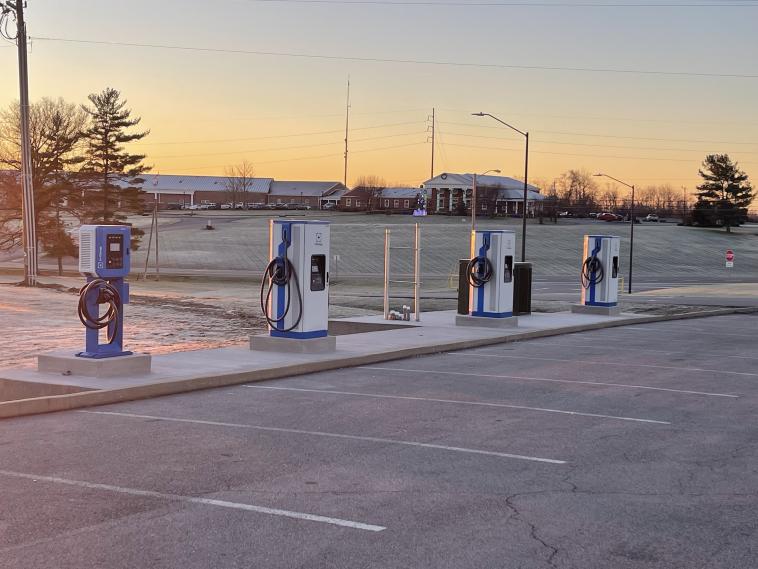
Climate benefits for future generations
People all over the country – and the world – are dealing with more severe and more common natural disasters, including hurricanes, floods, droughts, fires and extreme temperatures. This is due to climate change, which is caused by greenhouse gas emissions, like the exhaust from diesel-burning school buses.
Electric school buses produce less than half of the greenhouse gas emissions of diesel- and propane-burning school buses, even when accounting for the production of the energy used to charge the bus — and that number is expected to drop even more as the electric grid gets cleaner. In fact, in regions of the country with electric grids that are powered by lower-emissions energy sources, electric school buses account for as little as a quarter of the greenhouse gas emissions burned by diesel-burning school buses.
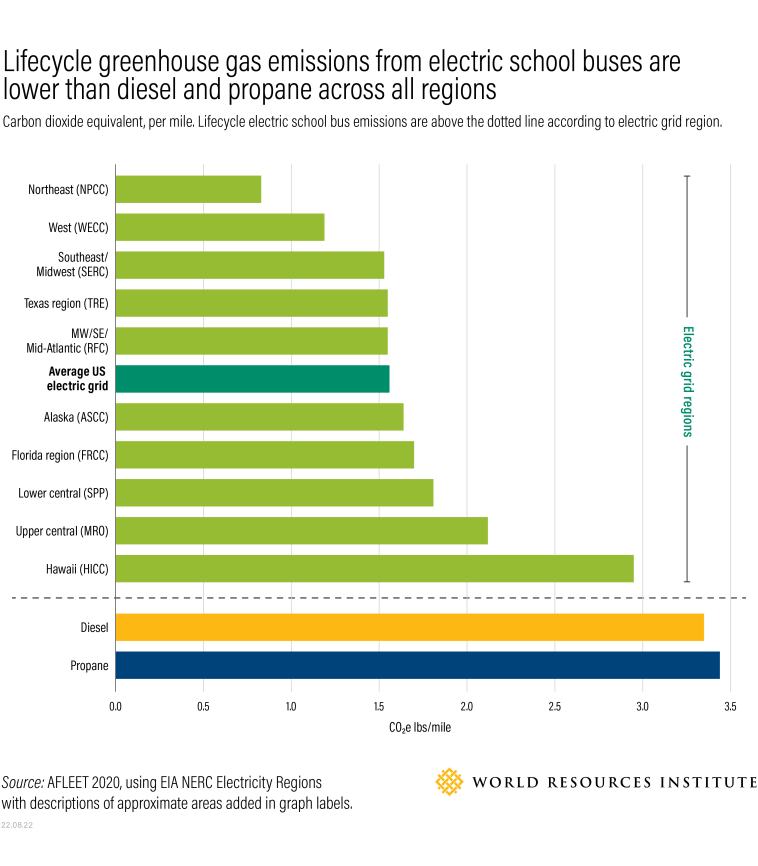
Electric school buses give kids a cleaner ride as soon as they step up the bus stairs, and they also play a role in protecting students – particularly in low-income communities and communities of color that are often on the frontlines of climate impacts – from climate-fueled extreme weather in the future.
In 2022, transportation was the sector that accounted for the highest percentage of greenhouse gas emissions in the U.S. (28%). To stop the most devastating impacts of climate change and keep the planet healthy for today’s students and future generations, the U.S. needs to cut back on greenhouse gas emissions as soon as possible. Relying less on fossil fuel-burning transportation – especially medium- and heavy-duty vehicles – can make a huge difference. Transitioning to electric school buses is one way to get started.
Electric school buses produce less than half of the greenhouse gas emissions of diesel- and propane-burning school buses, even when accounting for the production of the energy used to charge the bus.
Manufacturing jobs throughout the U.S.
Bringing these health, cost and climate benefits to communities nationwide also represents a major opportunity for a manufacturing renaissance across the country.
Already, school bus manufacturers are investing in electric school bus facilities needed to power this transition—and the jobs that come with them.
As of 2025, there are at least 21 manufacturing facilities of American-owned companies in 13 states making parts involved in the production of electric school buses. This is particularly impactful economically in Georgia, Michigan, Indiana, North Carolina and West Virginia, where major facilities are located. The industry continues to grow, with three major electric school bus manufacturers announcing plans for more than 1,500 new manufacturing jobs combined in the coming years. Companies are keeping jobs local, too: In West Virginia, one company is not only delivering buses to their local school district, they’re also employing alums.
The industry continues to grow, with three major electric school bus manufacturers announcing plans for more than 1,500 new manufacturing jobs combined in the coming years.
And that’s just the companies that employ workers directly involved in producing electric school buses.
Electric school bus manufacturing also supports thousands of jobs in related industries in the U.S. Each of the manufacturers and suppliers has a ripple effect, creating even more jobs from local third-party businesses including fabricators, wiring assemblers, bus seat producers and more. Jobs throughout the electric school bus supply chain support local economies and offer opportunities for workers to earn a good living.
Electrifying the transport sector overall is a huge opportunity for job creation in the U.S. One 2021 report projected that 10.7 million job-years could be created from the U.S. investing in electric vehicles, charging, supply chain, R&D and workforce.
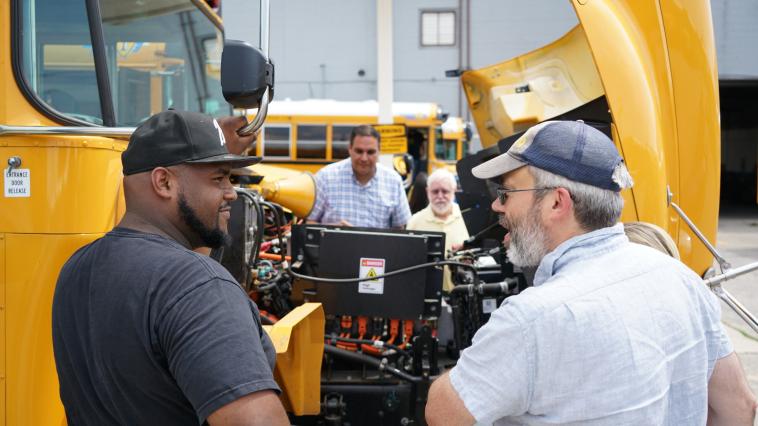
Building more resilient electric grids
When extreme weather hits — often fueled by climate change — communities may lose power. During heat waves or times of need for medical services, that can be particularly dangerous. But electric school buses offer a solution that can benefit everyone.
Using vehicle-to-everything (V2X) technology, electric school buses can serve as “mobile batteries” that provide clean energy in case of emergencies. That means electric school buses that are set up for V2X use can provide emergency electric power to keep the community safe, such as powering a school gymnasium to serve as a hurricane shelter.
These grid resiliency efforts are already underway.
Knox County in Illinois established a first-of-its-kind mutual aid agreement between a county government, a local public school system, and a school bus contractor. Under the agreement, if the county’s electric school buses are available, capable of bidirectional energy flows and charged, they can be used as needed by the county for backup power in case of emergency. If there’s a grid outage due to natural disasters like tornadoes or extreme heat waves, the county can use the buses to provide backup power for vital community needs including medical support.
Taking advantage of the energy-supplying potential of electric school buses is especially impactful for underserved communities who may not have access to a resilient electric grid or who lack adequate resources to respond to extreme weather.
But it doesn’t take a disaster for electric school buses to provide benefits to the electric grid. Using V2X technology can help improve grid flexibility and resiliency, present opportunities for compensation and enable the most efficient use of renewable energy. Having the electric school bus batteries available as offsite storage makes the grid stronger, and helping to build out more battery storage is an important part of strengthening the grid.
Benefits for those most harmed by diesel
Electric school buses provide benefits no matter where they’re located, because diesel exhaust pollution is bad for everyone. But some people and communities are more exposed to poor air quality and are more at risk of the harms that air pollution causes. That’s why the electric school bus transition offers an opportunity to reduce harmful pollution in the areas that need it most and to begin to address some historic wrongs.
Throughout the 20th century and into today, discriminatory practices in housing and transit development led to more pollution sources, like highways, being built closer to Black and Brown communities. Those decisions are having real impacts on the people who live in these locations.
Nationally, people of color are exposed to more diesel exhaust pollution and fine particulate air pollution – a type of pollution that’s too small to see in the air and has negative health effects like respiratory issues and asthma. These communities are experiencing way more air pollution than they are creating. In the United States, “pollution inequity” means that the non-Hispanic white population disproportionately creates air pollution by consuming goods and services, but that pollution is disproportionately inhaled by Black and Hispanic communities.
One study in the Northeast and mid-Atlantic found that communities of color face on-road fine particulate matter air pollution between 61% and 75% higher than white residents. In fact, race and ethnicity are more significant factors in exposure to air pollution than income level in the U.S.
Race and ethnicity are more significant factors in exposure to air pollution than income level in the U.S.
Asthma is one of the major concerns of diesel-burning school buses, and Black children, Hispanic children, Native American children and children from some Asian American communities are all more likely to suffer from asthma than their white counterparts.
Electric school buses offer an immediate way to start reducing the air pollution exposure of those who have been most harmed by diesel exhaust pollution.
The transition to an electric school bus fleet must be equitable, which means that it intentionally benefits those who are most harmed by diesel exhaust pollution. An equitable transition can involve prioritizing the most impacted populations for funding and ensuring communities are empowered to make decisions throughout the process.
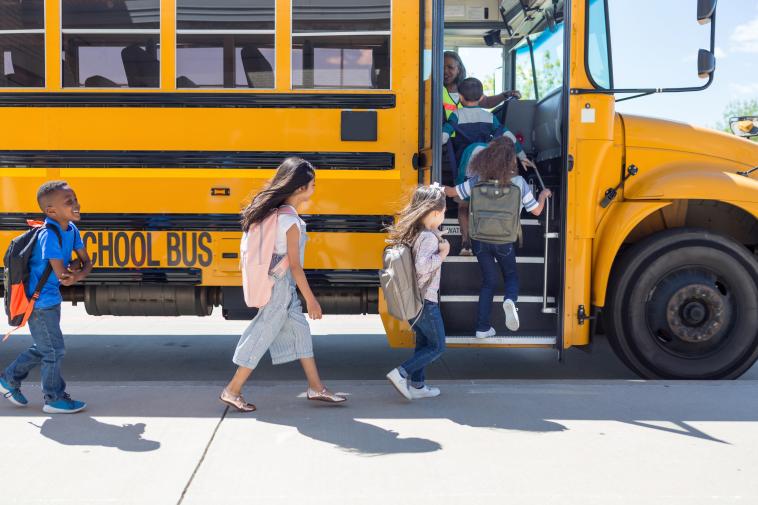
At the local level, it can mean that school districts choose to put their first electric school buses on routes with the worst air quality, to immediately reduce pollution in those areas. It can also mean ensuring that workers from historically disadvantaged communities be recruited and trained for well-compensated electric school bus jobs with adequate benefits, protections and accessible working conditions.
As the transition to electric school buses accelerates, there are opportunities throughout to center equity and build a healthier future for everyone.
The electric school bus transition offers an opportunity to reduce harmful pollution in the areas that need it most and begin to address some historic wrongs.
Learn more:
- FAQs About Electric School Buses
- Students Need Access to a Clean Ride to School
- The Transition to Electric School Buses Must Center Equity
- Why We Need to Transition to Electric School Buses
- All About the Range and Reliability of Electric School Buses
- All About Total Cost Ownership (TCO) for Electric School Buses